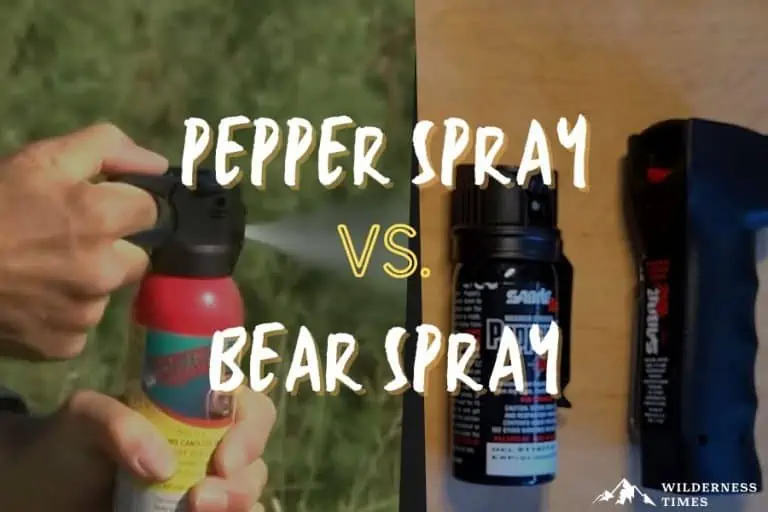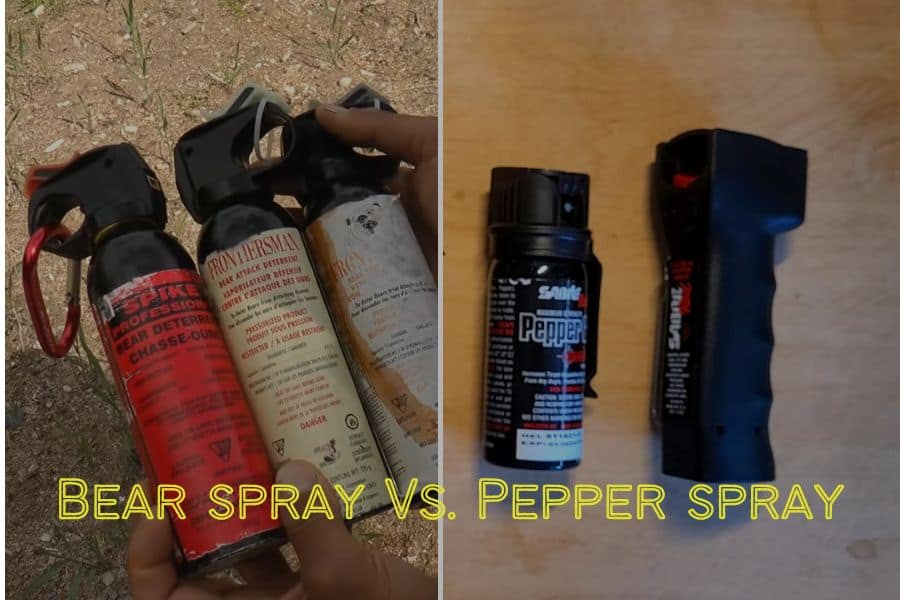It’s essential that you take extra steps to stay safe from bear attacks.
This includes a way to repel the aggressive animal charging you, but without causing it permanent damage.
Of course, there’s a perfect tool for the job – bear spray.
But if you already own pepper spray, it’s natural to wonder whether it will work just as well? After all, these two are pretty similar products.
However, there are some key differences that make these sprays unsuitable to use interchangeably.
Let’s get straight to it!
Bear Spray vs. Pepper Spray (What is the difference?)
The main difference is that bear spray has a much higher concentration of the same active ingredient, capsaicin or related capsaicinoids.
Bear spray is meant as a deterrent for bears. Pepper spray is meant to deter humans.
Because of its higher concentration, bear spray is much more dangerous than pepper spray to humans, and should not be used against them.
BEAR SPRAY | PEPPER SPRAY | |
Ingredients | Capsaicin (a compound found in peppers) and Water | Capsaicin (a compound found in peppers) and Water |
Concentration Level | 2% Major Capsaicinoids | 1.33% Major Capsaicinoids |
Pressurized | Yes | Yes |
Size | 9 Ounces | 2 Ounces |
Spray Time | 4-9 Seconds | 6 Seconds |
Dispersal Pattern | Expanding Cloud | Stream |
Range | 30 Feet | 10 Feet |
Effects Last For | 15-45 Minutes | 15-45 Minutes |
Pepper Spray: Essential Facts
- Designed as a self-defense mechanism against humans
- Has a range of about 10 feet
- Comes in a variety of sizes, from 0.5 to 16 ounces
- Compactly designed to fit a pocket
- Can be handled with one hand
- Legal to own, buy and carry in all states
- Doesn’t cause permanent damage to humans
Bear Spray: Essential Facts
- Designed as a bear repellent
- Has a range of 30 to 35 feet
- Packed in 8 to 10-ounce canisters
- The size of a spray can
- Should be held with both hands
- It’s considered a pesticide, so it’s legal to own
- If used on humans, can cause permanent damage to the eyes
Okay, so we’ve covered the most important facts to know about each of these sprays.
But they do appear quite similar in many ways, so let’s talk about each feature to see how they compare and contrast.
Capsaicin Levels
Both of these sprays use the same main ingredient – cayenne pepper.
Now, in the pepper world, cayenne isn’t at the top of the spicy list.
In fact, it falls somewhere in the middle. But if you were to rub your eyes after handling it… well, let’s just say you’d be blinded by tears for a good while.
The compound that makes your eyes sting is the fiery oil called capsaicin and its related alkaloids capsaicinoids.
The spiciness of peppers is measured in Scoville Heat Units, which go from 0 to 1,500,000+.
To give you a rough estimate of the numbers, here’s how many SHUs certain peppers have:
- Jalapeno – 2,500-8,000
- Tabasco Pepper – 30,000-50,000
- Ghost Pepper – 800,000-1,000,000
A typical pepper spray has between 500,000 and 5,000,000 SHUs.
A bear spray has 3,000,000 SHUs or more, so it’s three times more potent than pepper spray.
Spraying Distance/Pressure
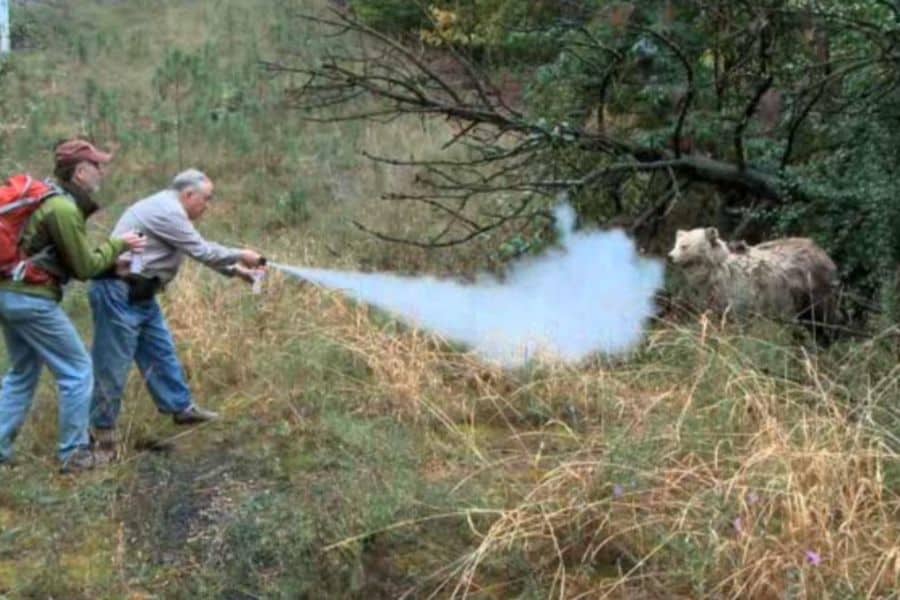
Both of these products are pressurized, but their spraying distance is different.
Pepper Sprays: With pepper sprays, you need to get a little closer. But you don’t need to wait for actual physical contact.
Most pepper sprays have a spray distance of 10 feet, but those numbers can go up and down depending on the model.
There are several different types of pepper sprays out there, all with different purposes.
A stream type of pepper spray can cover up to 20 feet, but that makes it unsuitable for indoors, as you can easily inhale or get splashed.
Pepper Gel: Pepper gel is more accurate, can travel further and has a low chance of wind blowback.
But it’s not as potent as other types of sprays and requires more precision when aiming.
Pepper Foam: Finally, we have pepper foam. This type of deterrent has a shorter spraying distance than the former two.
But at short range, it’s very precise, clings to the attacker and has no blowback.
Bear Spray: Bear sprays typically have a spraying distance of 30 to 35 feet, making them effective from a much further distance compared to pepper sprays.
However, a bear deterrent is dispensed widely – more like a fog than a stream – so it’s much harder to aim for the eyes with it.
But that’s actually the point of bear spray, as you want to start spraying as soon as you notice a bear charging at you.
In such a dangerous situation, there’s no time for aiming mistakes.
The Concentration of Oleoresin Capsicum
You might see both of these products available in different concentrations ranging from 5 to I0 percent.
But these numbers are more confusing than useful.
That’s because it’s not the volume of oleoresin capsicum that matters, but its potency.
And that depends on the percentage of capsaicinoids, which are the active ingredients in it.
The amount of OC in pepper spray can be anywhere between 1.2 to 12.6%.
But the concentration of capsaicinoids, which usually isn’t stated on the packaging, can range between 0.18% and 1.33%.
As for the bear spray, the Environmental Protection Agency restricts the oleoresin capsicum amount to just 2%.
However, capsaicinoids go anywhere between 1 and 2%, meaning it’s stronger.
So in reality, you want to look for the capsaicinoid content instead.
Legality
Pepper spray is legal to own in pretty much any state, but some might have specific regulations, such as the can size or capsaicin content.
For instance:
- California – pepper sprays with more than 2.5 ounces of aerosol spray are illegal to buy, own or use
- Massachusetts – you need a firearm identification card to buy, own or use pepper spray
- Michigan – pepper spray must not be stronger than 2% concentrate
- New York – you must be over 18 to buy pepper spray, and you can only get it at licensed firearm dealers or pharmacists
- Washington DC – owning pepper sprays requires registration with the Metropolitan Police
However, while it’s legal to own and carry pepper spray, it should only be used for self-defense purposes.
In case of an encounter with a human where you resort to using pepper spray, you might have to prove you were facing an imminent threat.
Bear spray, on the other hand, is not considered to be a self-defense weapon, but a pesticide.
And as such, it’s regulated by the Environmental Protection Agency.
You must be over 18 in order to buy bear spray, and that can only be done at the authorized dealers, with your name, address and signed agreement that you’ll only use it like it’s designated.
This is done to prevent people from using the bear spray as a weapon, as it can cause irreversible damage to your eyes.
Canister Design
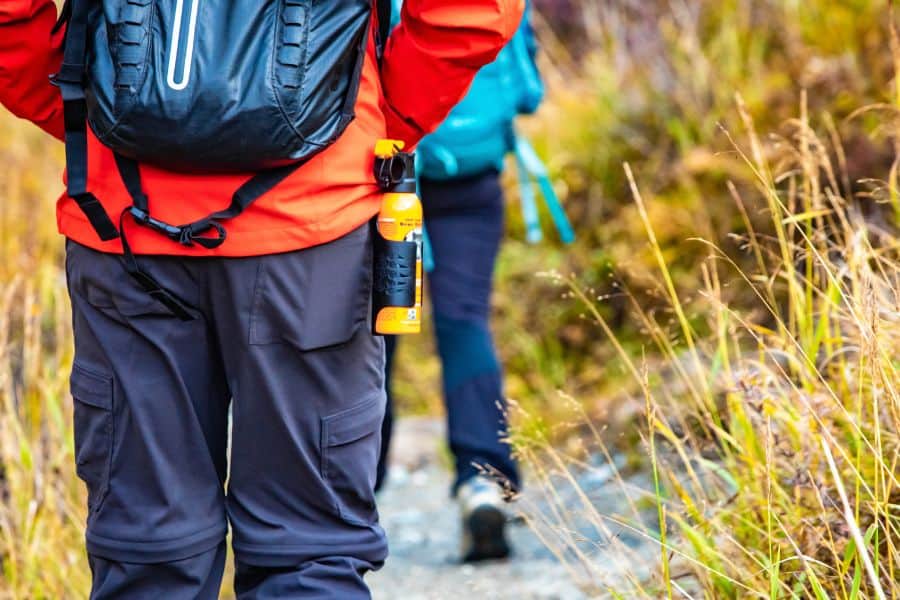
Given that it’s a self-defense weapon, pepper spray is packed in small canisters that you can easily hide in your pocket and take out in case of emergency.
And while they do come in different sizes, they’re generally the size of eye mascara.
As for bear sprays, they’re typically available in two sizes – 8 and 10 ounces.
And the slight difference in size between the two has a slight difference in the spraying distance.
Obviously, the larger the spray, the more you can spray in the direction the bear is charging from.
Uses
Both of these sprays should only be used to protect yourself in the case of imminent danger.
Bear Spray:
As the name suggests, bear spray is designated to repel bears.
You should never use it against humans, as it can cause irreversible damage to the eyes.
You can use bear spray for other dangerous animals, like coyotes, mountain lions, wolfs and even aggressive domestic dogs.
But given the fact that bear spray is designed specifically to work on a very large animal, it can cause harm to smaller animals.
Pepper Spray:
As for pepper spray, it’s a tool you can use to protect yourself against other humans.
Pepper spray was designed with humans in mind, and is safe to use on all of us.
Sure you could use it against bears, but it might be too weak of a deterrent and isn’t worth the risk unless that is your only option.
How to Use These Sprays?
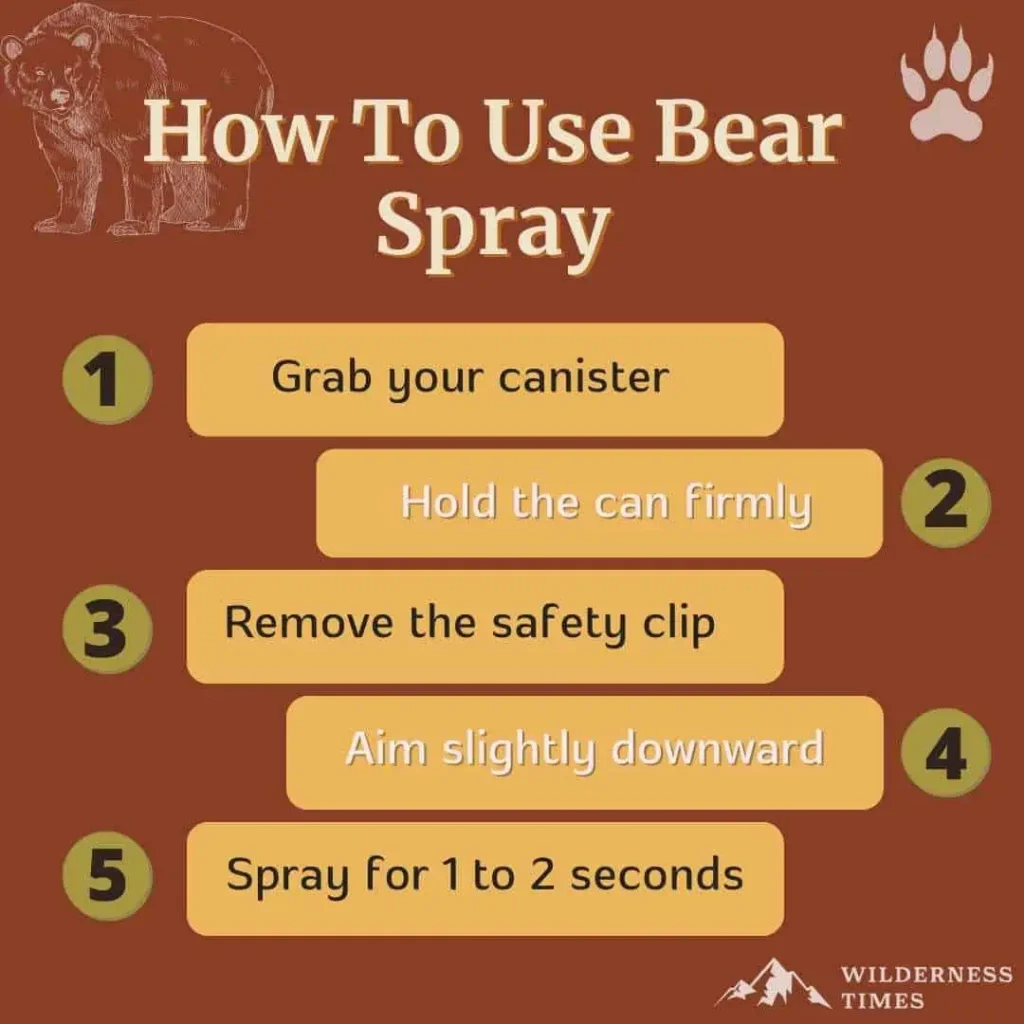
You should acquaint yourself with the way these sprays work, so that you can use them properly if such a situation emerges.
Otherwise, you could risk spraying yourself instead.
What’s true for both of these sprays is that you should keep them readily accessible, like in your pocket.
When holding, you need a firm grip – one hand is enough for pepper spray, but bear spray requires using two hands.
Start spraying in front of you when the attacker is 10 (human) or 20 (bear) feet away.
When Should You Use Bear Spray?
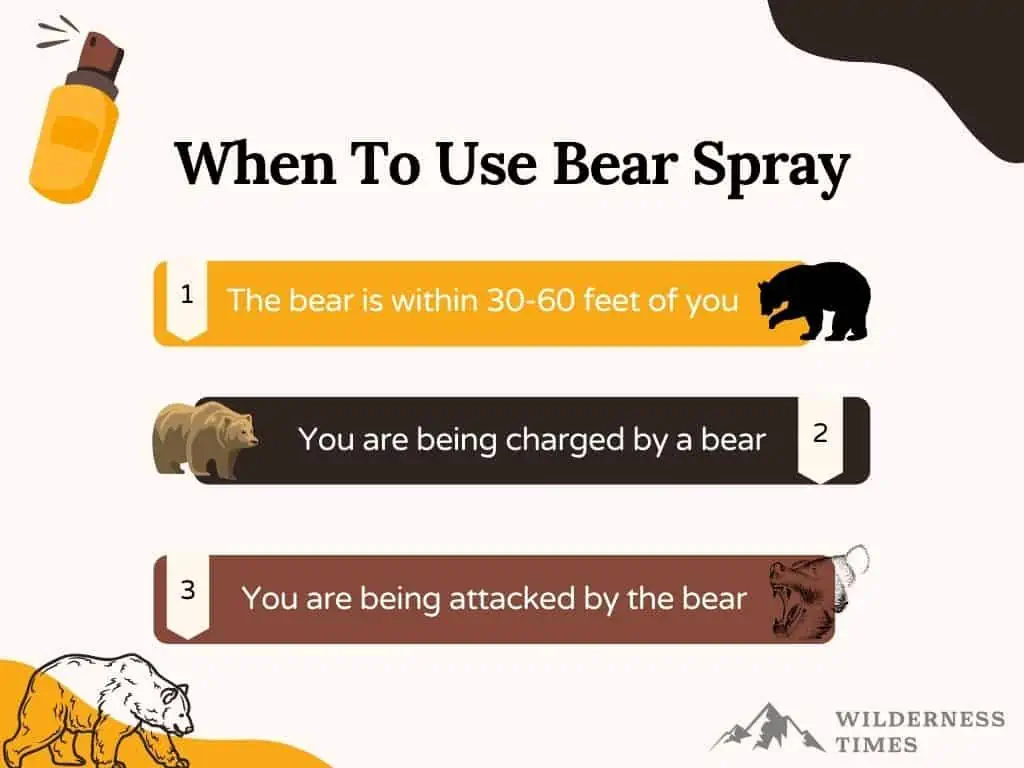
Both of these sprays are designated to be used only to defend yourself when in danger of physical harm.
This doesn’t mean you should start spraying as soon as you see a bear walking more than 100 feet away from you.
First, it won’t do anything as it’s out of range. And second, it might only draw more attention to yourself.
Instead, use a spray when the bear is in the spraying distance, while you’re getting charged or attacked by it.
Instead, start spraying when the bear is 30 or more feet away from you.
The same goes for pepper sprays. Using it without the actual danger of getting hurt by an attacker can get you into legal trouble.
How does bear spray work?
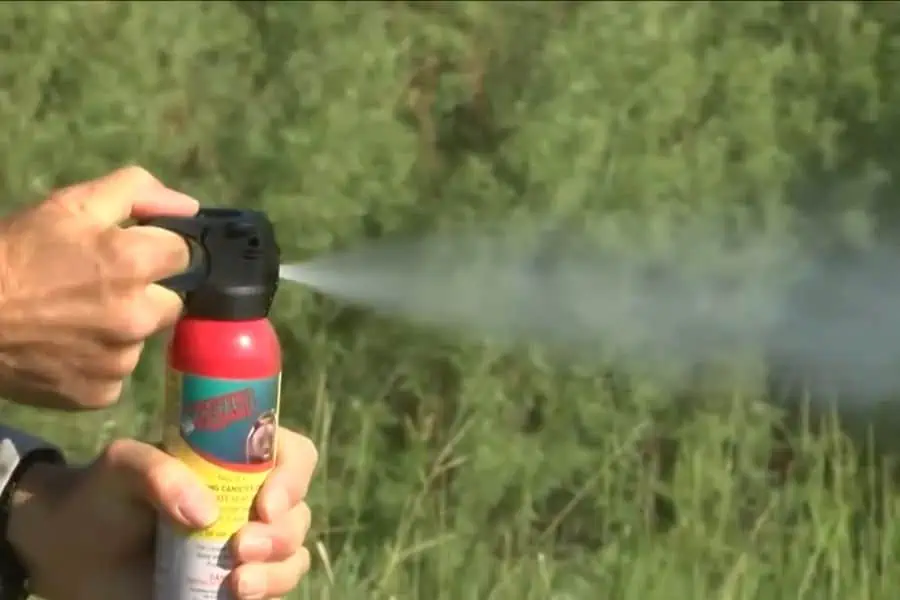
As we already established, both pepper and bear spray use oil extracted from cayenne peppers.
This oil contains chemical substances that give us that burning sensation on our tongues when eating something spicy.
But when you rub your eyes after cutting pepper, they sting.
That’s because oleoresin capsicum causes inflammation of the mucous membrane in your eyes.
And when inhaled, this compound does the same to your respiratory system.
It causes difficulty breathing, swelling of nasal passages, and coughing.
So while you struggle to see from teary eyes, you’ll also struggle to breathe normally for a good while.
The same effects apply to humans and bears when pepper and bear sprays are used respectively.
But the good thing is that these symptoms are temporary! The effect lasts no more than 90 minutes, which is enough time for you to run away from the threat.
Faqs
Is using bear spray on a human legal?
While it’s not specifically prohibited by law, you shouldn’t use bear spray on humans.
Considering it’s quite potent, bear spray can cause permanent damage, and there was a case of a man dying from it.
So unless you’re acting in self-defense, you could face legal punishments for using bear spray on humans.
Can you use pepper spray as bear spray?
Theoretically, yes. But pepper spray is nowhere near potent as bear spray, so it might work as a repellent against the bear.
What happens if you spray a human with bear spray?
The effects of the bear spray are similar to those of pepper spray – irritated eyes, nose and lungs.
But the intensity of these effects can be much stronger.
You might struggle to keep your eyes open from all the stinging and water, and you’ll probably cough for the duration of the effects.
Are pepper spray and bear spray the same?
Both of these sprays use the same ingredients and work in a similar matter.
But while pepper spray is designed for use against humans, bear spray is meant for use on bears, mountain lions, dogs, wolfs, coyotes and other animals.
The difference between the two lies in their potency.
Which is better bear spray or pepper spray?
This depends on why you need such a product. For self-defense against humans, pepper spray is your tool.
For bears, bear spray is irreplaceable. You should never use any of these sprays for any purpose other than that.
Will bear spray work on mountain lions?
Bear spray is designed to work on large animals, so mountain lions shouldn’t be a problem.
If a mountain lion is attacking you, start spraying from over 20 feet, so that the spray repels it before it reaches you.
How much does the bear spray cost?
The numbers vary from manufacturer to manufacturer, but most bear sprays cost between $40 and $60 per can.
To Sum Things Up
As you can see, these two sprays feature the same ingredients and serve the purpose of repelling the attacker.
But there are some key factors that prevent you from using them interchangeably.
Being much stronger, bear spray is only suitable for bears and possibly other big and aggressive animals.
And for the same reason, pepper spray is not strong enough to deal with bear attacks.
So what to do? Your best option is to own both of these sprays and choose between them depending on the situation.


